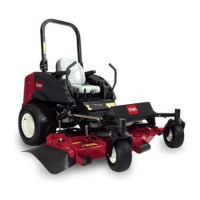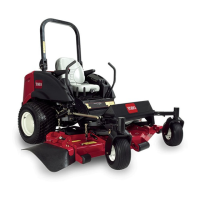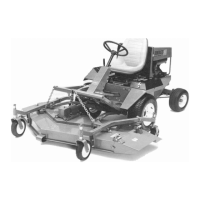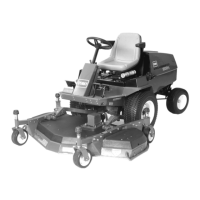Figure 71
1. Cutting Edge 3. Wear/slot Forming
2. Curved Area 4. Crack
If y ou allo w the blade to w ear , a slot will
f or m betw een the sail and flat par t of the
blade. Ev entuall y a piece of the blade
may br eak of f and be thr o wn fr om under
the housing , possibl y r esulting in serious
injur y to y ou or bystander s.
• Inspect the blade periodicall y f or
w ear or dama ge.
• Nev er tr y to straighten a blade that
is bent or w eld a br ok en or crack ed
blade.
• R eplace a w or n or dama ged blade.
Checking for Bent Blades
1. Diseng ag e the PTO , mo v e the motion control
lev ers to the neutral loc k ed position and set
the parking brak e .
2. Mo v e the throttle lev er to the Slo w position,
stop the engine , remo v e the k ey , and w ait for
all mo ving par ts to stop before lea ving the
operating position.
3. R otate the blades until the ends face forw ard
and bac kw ard ( Figure 72 ). Measure from a
lev el surface to the cutting edg e , position A , of
the blades ( Figure 72 ). Note this dimension.
Figure 72
1. Measure here from blade
to hard surface
2. Position A
4. R otate the opposite ends of the blades forw ard.
5. Measure from a lev el surface to the cutting
edg e of the blades at the same position as
in ste p 3 abo v e . T he difference betw een the
dimensions obtained in ste ps 3 and 4 m ust not
ex ceed 1/8 inc h (3 mm). If this dimension
ex ceeds 1/8 inc h (3 mm), the blade is bent
and m ust be re placed; refer to R emo ving the
Blades and Installing the Blades .
64
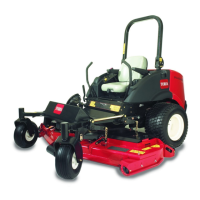
